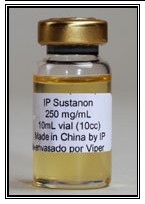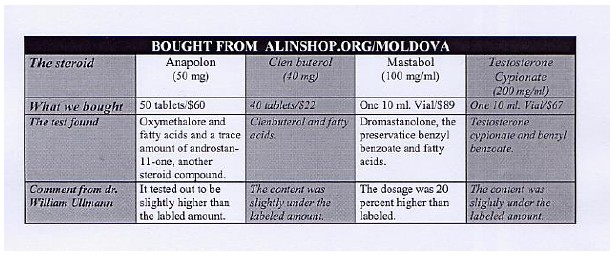Poison in a package
Tests found lead, tin, arsenic and a cancer-causing cattle fattener mixed in with steroids. The Courant bought over the Internet
 Dangerous. That was the first word out of the scientist's mouth after seeing test results on three batches of anabolic steroids The Courant bought from black market websites in Poland, Spain and Moldova. Reckless was another description. Poison, a third.
Dangerous. That was the first word out of the scientist's mouth after seeing test results on three batches of anabolic steroids The Courant bought from black market websites in Poland, Spain and Moldova. Reckless was another description. Poison, a third.
Tests by a team at Northeast Laboratories in Berlin, led by William Ullmann, showed a small amount of lead in one of the steroid samples, a liquid injectable that users shoot into their muscle.
Traces of a banned, cancer-causing cattle fattener were found in a second sample. A third steroid proved to be nearly twice as concentrated as the amount on the label, raising overdose concerns. A fourth was labeled as one steroid, but was another. A fifth sample contained traces of a flammable liquid used in the production of plastics.
On November 6, 2005 a journalist from the The Hartford Courant, bought some samples on the web and had them analysed. We should take the outcome not to seriously, because the toxic compounds found in the samples are not linked to doses, thus it can easily be trace amounts. We should also know that we eat and breath toxic compounds every day. In order to make a juicy story, and the journalist is of course also influenced by the official steroid scaremongering to scare (young) people away from usage, they report these toxics. But still it shows that we should be carefull with what we buy and where we buy it. This site and those working here will try to give you objective advise and information. And I know what I'm talking about, I analysed many times to detect toxic compounds etc etc, for articles, books, magazines.and our website. Sometimes also with REAL shocking results, also with peptides..
This is why federal agents, drug prosecutors and drug-industry regulators say they find Internet steroids terrifying.
"You would not want your loved ones anywhere near this stuff," Ullmann said. He's the owner and founder of Northeast Laboratories, which has tested drugs, food, air, water, molds and a multitude of other compounds for industry and government clients since 1976.
 Ullmann is the former director of the laboratory division of the state Department of Public Health, and is a scientist with 55 years of experience. His team at Northeast tested 13 samples using a gas chromatograph. Specimens were vaporized, then injected into a column of gas, their component parts recorded on computer printouts.
Ullmann is the former director of the laboratory division of the state Department of Public Health, and is a scientist with 55 years of experience. His team at Northeast tested 13 samples using a gas chromatograph. Specimens were vaporized, then injected into a column of gas, their component parts recorded on computer printouts.
Ullmann said this was one of the toughest assignments he's handled, and the findings were alarming.
 The team found small amounts of arsenic and tin in the sample of Deca Durabolin[from vipershop.org, Spain], one of the most popular bodybuilding steroids. Ingested over a period of weeks, as bodybuilders do when they're on a 10- or 12-week cycle, the tin can cause headaches, vertigo and problems in the nervous system, Ullmann said. The arsenic - trimethylsilyl arsenous acid - can cause cancer.
The team found small amounts of arsenic and tin in the sample of Deca Durabolin[from vipershop.org, Spain], one of the most popular bodybuilding steroids. Ingested over a period of weeks, as bodybuilders do when they're on a 10- or 12-week cycle, the tin can cause headaches, vertigo and problems in the nervous system, Ullmann said. The arsenic - trimethylsilyl arsenous acid - can cause cancer.
The team found small amounts of lead in the vial of liquid Equipoise[from vipershop.org, Spain], an injectable steroid. The lead can cause illnesses similar to tin poisoning, only more severe. Traces of benzyl chloride also showed up, a preservative that can produce pulmonary edema (fluid in the lungs).
"Like the tin, lead is a cumulative poison. First it goes into the soft tissue, then it works its way into the bone, where it can be stored for years and be released by an illness or reaction to a medication. And here, you're shooting it right into your muscle," Ullmann said.
In the Testosterone Enanthate [from marssel4bolex.com, Poland], the team found traces of diethylstilbestrol, once used as a growth promoter in cattle. Diethylstilbestrol was banned by the federal government in the 1970s for animals used for foods, because it was found to cause cancer.
Diethylstilbestrol, also known as DES, was used as a synthetic estrogen for pregnant women from the 1950s to early 1970s, when it was linked to vaginal cancer.
"This was supposed to be the answer to farmers growing fatter livestock," Ullmann said. "It may still be used as a growth promoter somewhere in the world."
Traces of flammable Furfural, used to make plastics, showed up in the Bionabol sample [from vipershop.org, Spain].
"I don't know how that would have gotten in there," Ullmann said. "It is a contaminant in this case. They could have been using dirty equipment, or maybe the equipment was used for something else beforehand. Lord knows."
Then came the tests on Winstrol[from vipershop.org, Spain], the trade name for stanazolol, the powerful steroid linked to slugger Rafael Palmeiro
The label on the bottle, shipped from Madrid, said each pill was 50 milligrams. Ullmann's team found they were 91 milligrams each, a concentration of steroids 82 percent higher than the amount on the label.
"It's loaded and there's no instructions on how much to take," Ullmann said.
"Seems to me, it's pretty doggone dangerous. If a kid takes one of these, he might think two is good, and three is even better. Then we're getting serious," Ullmann said of the overdose threat.
Doctors, bodybuilders and former steroid abusers told The Courant that inexperienced users tend to take more of the drug than less. They self-medicate, then seek out advice from seasoned users in the online chat rooms of steroid.com and elitefitness.com.
 All of the samples tested positive for steroids, but some had dosages that were significantly weaker than the labeled amount.
All of the samples tested positive for steroids, but some had dosages that were significantly weaker than the labeled amount.
Ullmann said this suggested that either the chemicals in those samples were old and losing their potency, or that the steroid peddlers had diluted the chemicals to stretch the product, as heroin, cocaine and marijuana dealers are known to do.
A second sample of Deca Durabolin [from marssel4bolex.com, Poland] proved to be mislabeled. It turned out to be another powerful steroid, testosterone propionate.
"It's like getting a mislabeled drug from a pharmacy. You don't know what you're taking," Ullmann said.
"This goes beyond concerns about the long-term health effects of steroid abuse," Ullmann said of the overall test results.
"First, you have the labeling problem. If there's no instructions on how many to take in a 24-hour period, it would not be hard to overdose. The whole thing is reckless; it shows poor production. It appears in some cases they weren't careful about how they mixed the compounds.
"It's all very disturbing."

- Login to post comments


